Splunk Competitors Shortlist
After a thorough evaluation, I've curated a list of standout Splunk competitors. Each solution was selected for its potential to effectively address your specific data challenges.
- Elastic - Best for scalable search and data visualization
- Amazon Web Services (AWS) - Best for comprehensive cloud computing needs
- Logz.io - Best for AI-powered log analysis
- Coralogix - Best for real-time data insights and anomaly detection
- New Relic - Best for application performance monitoring
- Zabbix - Best for open-source network monitoring
- Mezmo Log Analysis - Best for streamlined log management
- Sumo Logic - Best for cloud-native machine data analytics
- AppDynamics - Best for end-to-end business transaction tracking
- LogicMonitor - Best for automated hybrid infrastructure monitoring
- Datadog - Best for full-stack observability and integration capabilities
- Dynatrace - Best for AI-assisted cloud infrastructure monitoring
As someone who has delved deep into the Security Information and Event Management (SIEM) world, I understand the need for an SIEM solution that can effectively aggregate endpoint data from various sources, analyze user behavior, and provide actionable security analytics.
Splunk, an industry leader in this space, excels in assimilating machine-generated data, offering plugins for various data sources, behavior analytics, and providing a comprehensive platform for security operations or cybersecurity with notable threat detection and threat intelligence features.
However, only some SIEM platforms will be a perfect fit for some organizations, as factors like cost, specific use cases, or different data handling needs can push you to look for Splunk competitors.
Overview of the 12 Splunk Competitors
1. Elastic - Best for scalable search and data visualization
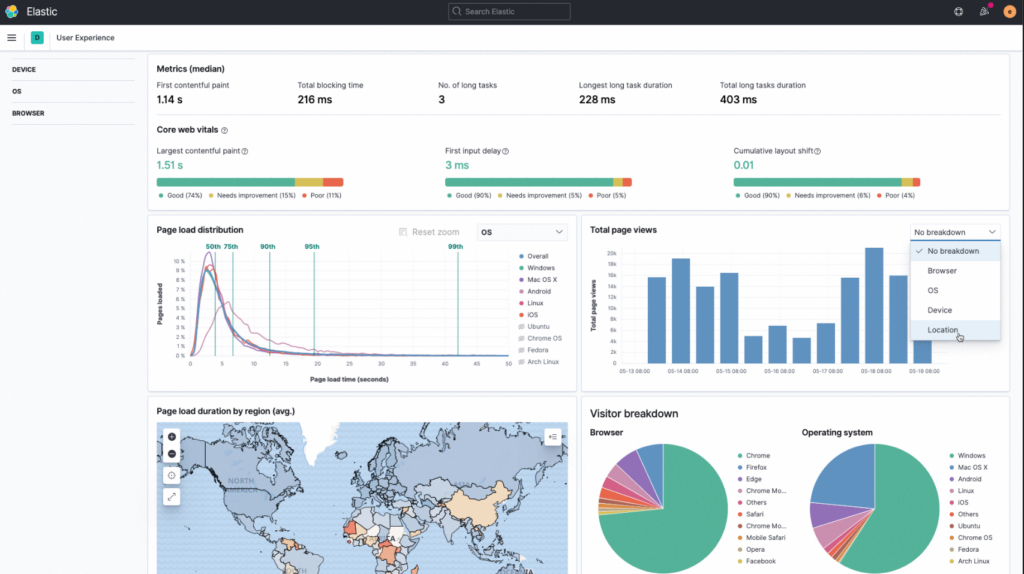
Elastic, also known as Elasticsearch, is a robust, open-source search and analytics engine that can swiftly manage colossal amounts of data. Its forte lies in handling various types of data, making it versatile enough to deal with log and event data, and it excels particularly in scaling search and data visualization tasks.
Why it's a good Splunk competitor:
I selected Elastic as a formidable competitor to Splunk primarily because of its scalability and versatility in handling different data types. Its robust capabilities in search and data visualization tasks make it stand out. The company specializes in self-managed and SaaS solutions for security, observability, logging, and search. When it comes to being the best for scalable search and data visualization, Elastic's real-time search functionality, combined with powerful analytics ticks all the boxes.
Standout features & integrations:
Critical features of Elastic include real-time search, distributed search, analytics, and multi-tenancy. Its Elastic Stack, which provides Elasticsearch for search, Logstash for centralized logging, and Kibana for visualization, sets it apart from many other platforms. Elastic integrates smoothly with various software, including Apache Hadoop, Apache Cassandra, MongoDB, and Grafana.
Pricing:
Elastic pricing starts from $16/user/month, billed annually. Lower-priced plans offer robust search capabilities, while higher tiers provide additional features and support.
Pros:
- Offers powerful real-time search capabilities
- Handles multiple data types effectively
- Provides a comprehensive and versatile suite (ELK Stack)
Cons:
- Learning curve can be steep for beginners
- Costs can increase significantly with high data volumes
- Advanced features are locked behind higher pricing tiers
2. Amazon Web Services (AWS) - Best for comprehensive cloud computing needs
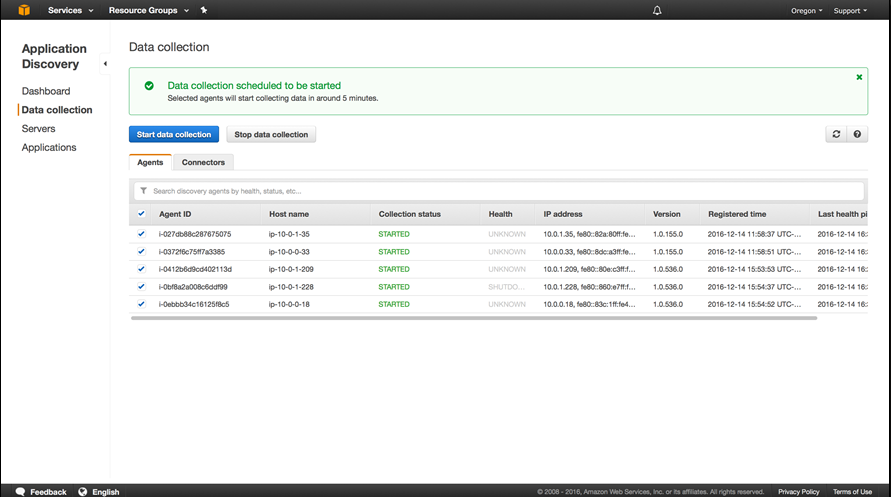
Amazon Web Services, often called AWS, is a global leader in providing on-demand cloud computing platforms and APIs. As a subsidiary of Amazon, AWS offers an extensive suite of cloud services that enable businesses to run sophisticated and scalable applications, making it ideal for comprehensive cloud computing needs.
Why it's a good Splunk competitor:
Regarding Splunk enterprise alternatives, I selected AWS due to its wide array of cloud services and overall flexibility. Its extensive capabilities and the capacity to handle virtually any cloud computing need to distinguish AWS from many other platforms. AWS is best for comprehensive cloud computing needs as it offers a variety of tools, from computing and storage to analytics and machine learning, thereby accommodating a wide range of business requirements.
Standout features & integrations:
AWS offers over 200 fully featured services from data centers globally, including computing power, storage, databases, networking, analytics, and machine learning. Key AWS features include AWS Lambda for serverless computing and Amazon S3 for scalable storage. Necessary integrations for AWS include various software and services such as Salesforce, Adobe, SAP, Oracle, and Microsoft Azure.
Pricing:
Pricing for AWS varies based on the specific services used but starts from $8.50/user/month. Different services have different pricing models, designed to let you pay only for what you use.
Pros:
- Broad array of services catering to various cloud computing needs
- Strong security measures and protocols
- Highly scalable and flexible offerings
Cons:
- Can be complex to navigate due to the range of services
- Costs can quickly escalate with increased usage
- The learning curve can be steep for those new to cloud computing
3. Logz.io - Best for AI-powered log analysis
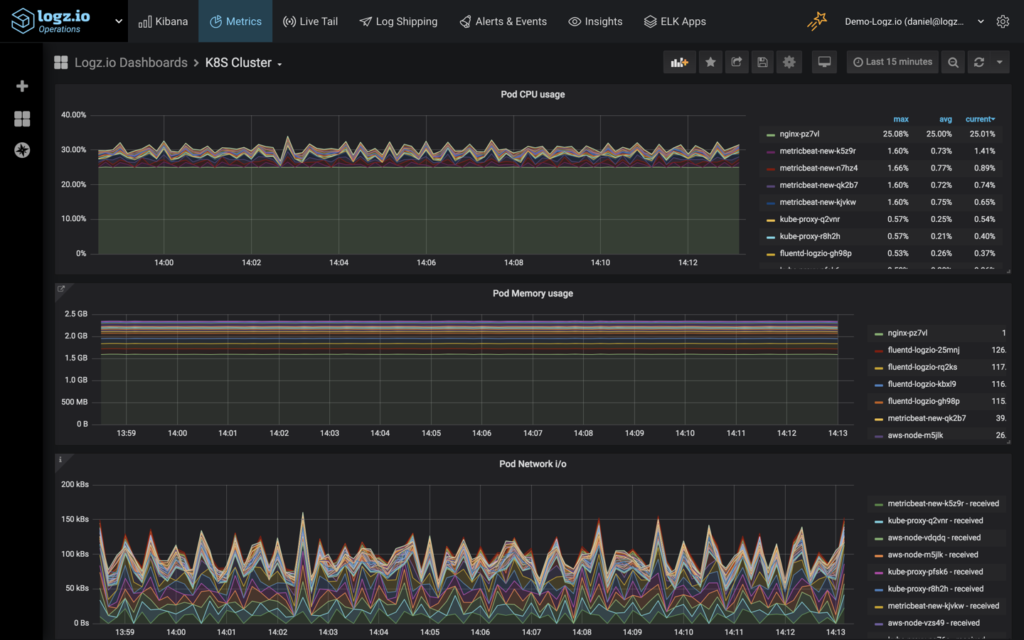
Logz.io is an innovative platform that utilizes artificial intelligence for log analysis. This advanced tool offers scalable and intelligent machine data analytics, designed to make log monitoring more efficient and insightful, thus making it perfect for AI-powered log analysis.
Why it's a good Splunk competitor:
I chose Logz.io as a top Splunk competitor due to its pioneering use of AI in log analysis. What sets it apart is its unique combination of open-source software and machine learning technology to generate predictive insights. It's "best for AI-powered log analysis" as it effectively leverages machine learning to proactively uncover potential issues and provide actionable insights, making it a real game-changer in the log analysis realm.
Standout features & integrations:
Key features of Logz.io include predictive fault detection, advanced machine learning algorithms, and distributed tracing capabilities. Its Kibana UI and pre-made Kibana objects enhance data visualization. Logz.io integrates effectively with popular tools such as AWS, Azure, Google Cloud, Docker, and Kubernetes.
Pricing:
Logz.io pricing starts from $49/user/month, billed annually. Different plans offer varying data volumes, features, and levels of support.
Pros:
- AI-driven predictive fault detection
- Intuitive Kibana UI for data visualization
- Comprehensive integrations with cloud and container platforms
Cons:
- Higher learning curve due to AI functionalities
- Costlier than some other log analysis platforms
- Advanced features available only in higher pricing tiers
4. Coralogix - Best for real-time data insights and anomaly detection
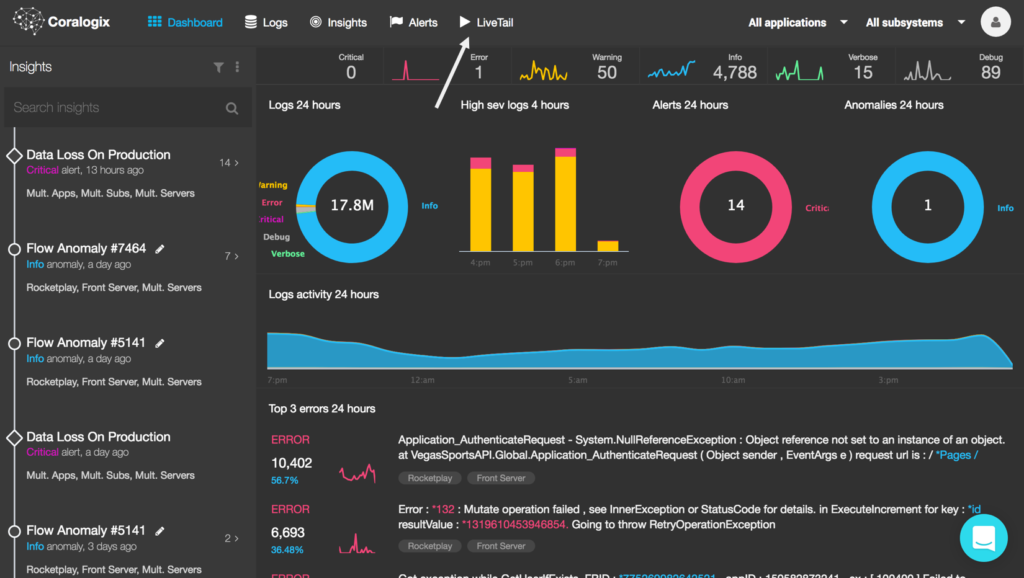
Coralogix provides a cutting-edge log analytics platform that empowers businesses to extract actionable insights in real-time. It's built to offer top-tier anomaly detection, focusing on troubleshooting, monitoring, and security, securing its position as the best for real-time data insights and anomaly detection.
Why it's a good Splunk competitor:
I selected Coralogix for its unique real-time data analysis and powerful anomaly detection capabilities. It delivers immediate insights from logs, making it a reliable option for organizations keen on troubleshooting and proactive monitoring. Its forte in real-time insights and anomaly detection substantiates why it's the "best for" these specific needs.
Standout features & integrations:
Coralogix provides robust features, including real-time live tail, trend analysis, advanced anomaly detection, and fully customizable dashboards. It integrates with numerous popular platforms, such as AWS, Kubernetes, Docker, and more, expanding its monitoring and troubleshooting capabilities.
Pricing:
Pricing for Coralogix starts from $50/user/month, plus a base fee of $80 per month. The cost may vary depending on the level of support and data volume requirements.
Pros:
- Exceptional real-time data analysis
- Advanced anomaly detection features
- Extensive platform integrations
Cons:
- Higher pricing for larger data volumes
- Requires technical expertise for setup and usage
- Additional base fee is required
5. New Relic - Best for application performance monitoring
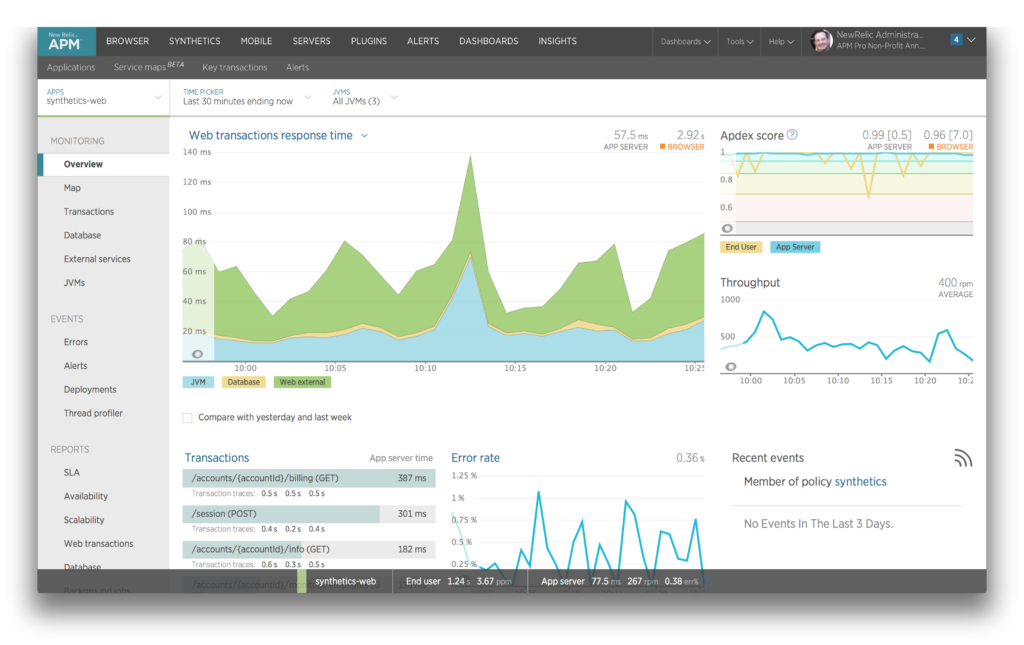
New Relic is a comprehensive software analytics platform that offers real-time insights into your application's performance. It excels at tracing application issues back to their source, making it the top pick for application performance monitoring.
Why it's a good Splunk competitor:
I chose New Relic due to its advanced application performance monitoring capabilities. The tool stands out because it can dive deep into your software stack and provide comprehensive insights. This, paired with real-time performance tracking, validates its position as the "best for" application performance monitoring.
Standout features & integrations:
New Relic offers robust features such as real-time user monitoring, application tracing, and infrastructure monitoring. Additionally, its ability to integrate with cloud platforms like AWS, Azure, Google Cloud, and software development tools like Jira, Slack, and GitHub offers a rounded monitoring solution.
Pricing:
Pricing for New Relic starts from $99/user/month (billed annually).
Pros:
- Comprehensive application performance monitoring
- Extensive integration options
- Real-time user monitoring
Cons:
- High starting price
- Steeper learning curve for beginners
- Annual billing cycle might not suit all businesses
6. Zabbix - Best for open-source network monitoring
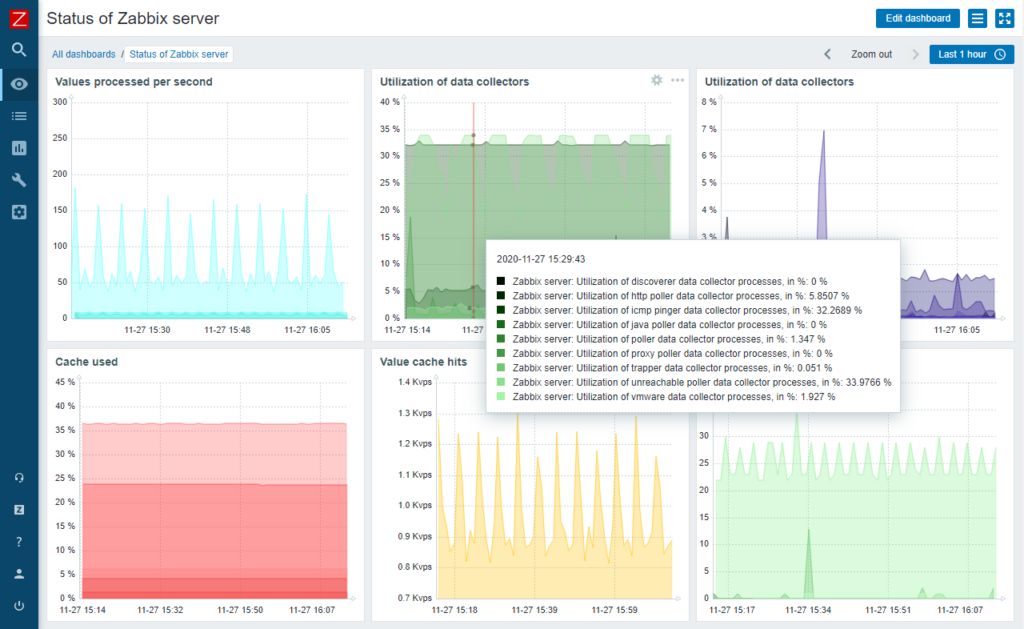
Zabbix is an open-source monitoring solution designed to track, record, alert, and visualize data from different IT environments. Its emphasis on network monitoring and its cost-effective nature makes it a prime choice for organizations seeking an open-source network monitoring solution.
Why it's a good Splunk competitor:
I selected Zabbix because its powerful open-source design provides robust network monitoring functionalities. Unlike other platforms, Zabbix offers a customization level ideal for organizations with unique monitoring requirements. The fact that it's specifically geared towards network monitoring further supports its placement as the "best for" open-source network monitoring.
Standout features & integrations:
Key features of Zabbix include flexible problem detection, visual representation of data, and distributed monitoring. Its open-source nature allows for extensive integration capabilities with ITSM tools like Jira and ServiceNow, cloud platforms like AWS and Azure, and even other open-source tools like Grafana.
Pricing:
As an open-source platform, Zabbix is free to use.
Pros:
- Extensive network monitoring capabilities
- Open-source and highly customizable
- Wide array of integrations possible
Cons:
- May require technical expertise to set up and customize
- Lack of official support, relies on community assistance
- User interface could be more intuitive
7. Mezmo Log Analysis - Best for streamlined log management
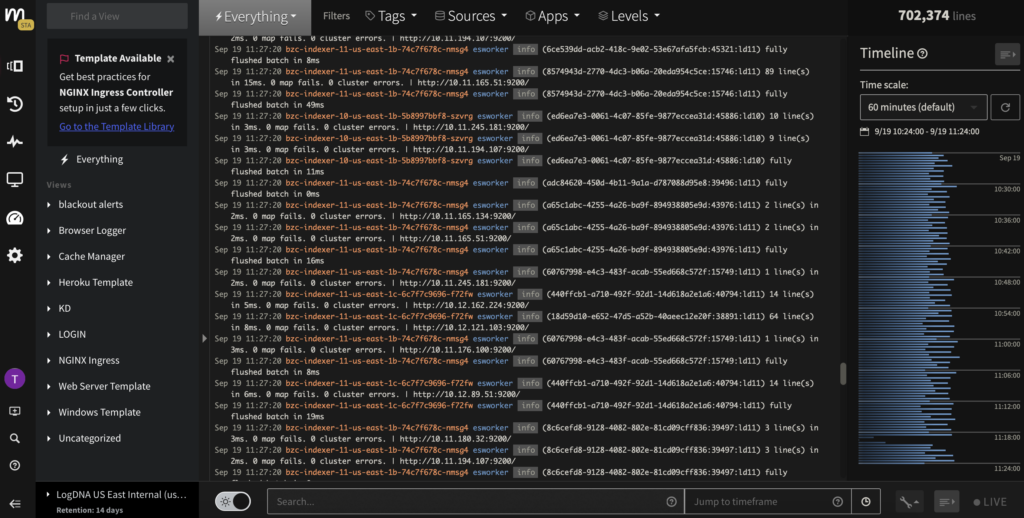
Mezmo Log Analysis is a logging tool designed to simplify the log management process, making it more efficient and organized. It focuses on facilitating the often complex and scattered process of managing logs, aligning it with organizations seeking a more streamlined approach.
Why it's a good Splunk competitor:
I included Mezmo Log Analysis in this list as its simplicity and user-friendly interface provide a refreshing change to the often complicated log management tools available. The choice was made due to the product's specific emphasis on streamlined log management, which I determined was a unique selling point that made it stand out.
Standout features & integrations:
Mezmo Log Analysis has features such as intelligent searching, detailed visualization, and real-time alerts. It provides integrations with a range of common platforms, including Kubernetes, Docker, and various cloud services, which expands its applicability across different environments.
Pricing:
The pricing for Mezmo Log Analysis starts from $15/user/month.
Pros:
- User-friendly and intuitive interface
- Effective search capabilities
- Wide range of integrations
Cons:
- May lack advanced features found in more established tools
- Limited customization capabilities
- Relatively new, so less community support available
8. Sumo Logic - Best for cloud-native machine data analytics
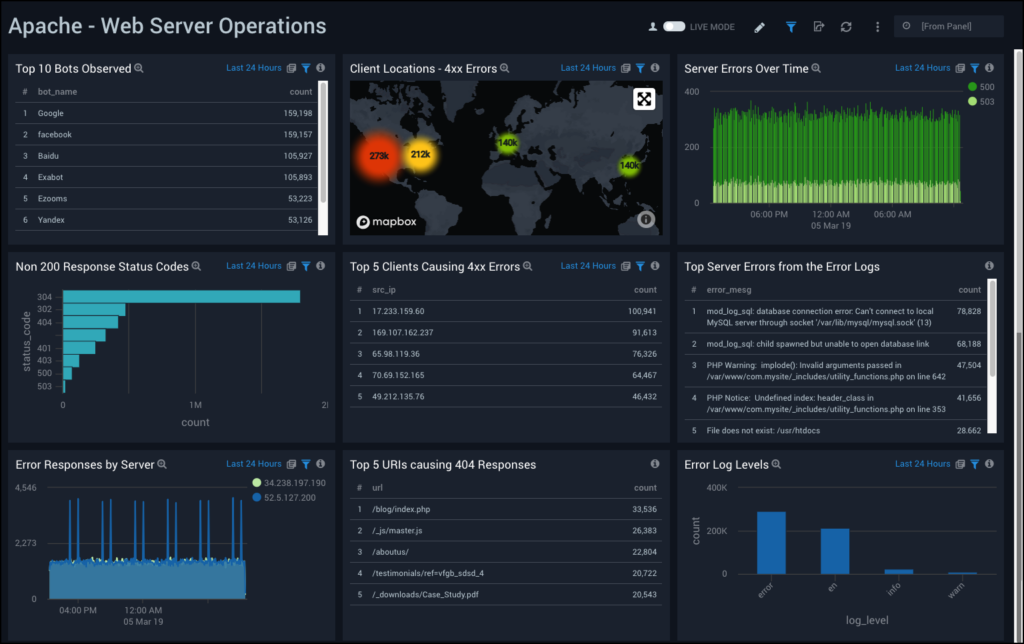
Sumo Logic is a robust platform that specializes in machine data analytics. The tool is designed to collect, store, and analyze data, which makes it a preferred choice for companies looking for comprehensive analytics in a cloud-native environment.
Why it's a good Splunk competitor:
I selected Sumo Logic for this list due to its focus on cloud-native environments, which sets it apart in the crowded log analysis market. It is particularly well-suited to companies operating within the cloud, making it a strong choice for those seeking specialized analytics and monitoring.
Standout features & integrations:
Sumo Logic provides features such as real-time data insights, advanced analytics capabilities, automated data collection, and machine learning tools. It integrates well with various platforms including AWS, Azure, and GCP, enabling it to fit within most cloud-native environments.
Pricing:
The starting price for Sumo Logic is $108/user/month (billed annually).
Pros:
- Strong focus on cloud-native environments
- Extensive analytics capabilities
- Robust integrations with major cloud platforms
Cons:
- High starting price might not be affordable for smaller organizations
- Might be overkill for companies without substantial data analytics needs
- The interface can be complex for beginners
9. AppDynamics - Best for end-to-end business transaction tracking
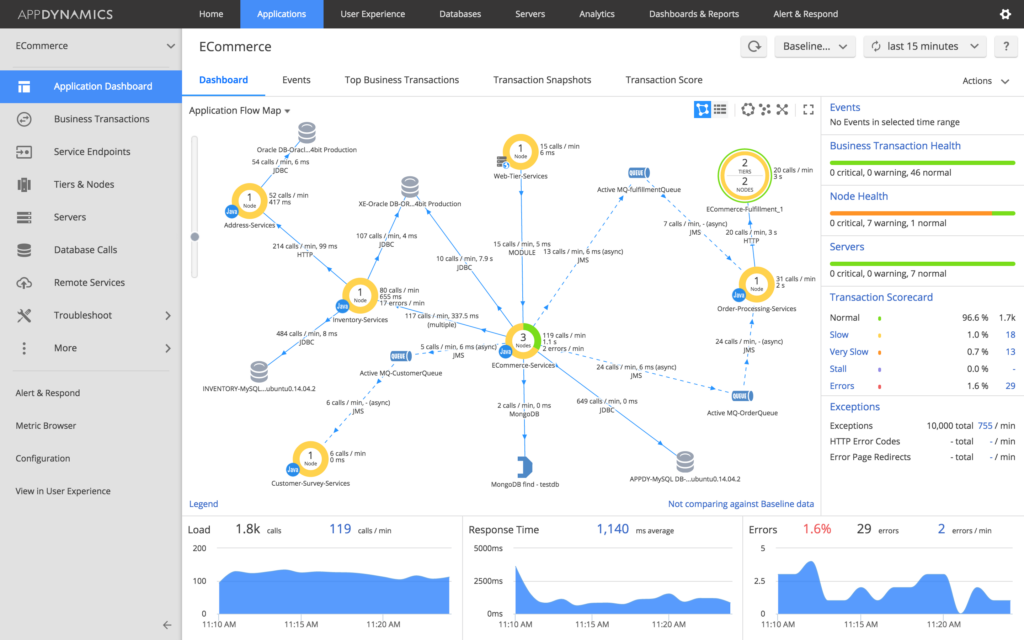
AppDynamics is an application performance management (APM) and IT operations analytics (ITOA) company. The platform is designed to monitor and track the performance of business transactions across multiple layers and tiers, making it ideal for end-to-end business transaction tracking.
Why it's a good Splunk competitor:
AppDynamics made my selection list because of its distinct ability to provide detailed transaction tracking across a business operation. It stands apart from this focus on complete visibility of transactions, making it a suitable tool for organizations that require thorough tracking and monitoring of their business activities.
Standout features & integrations:
AppDynamics offers a unified view of application performance and user experiences, comprehensive diagnostic capabilities, and dynamic baselining and alerting. It integrates effectively with numerous other platforms, including AWS, Azure, and GCP, allowing streamlined operations across multiple services.
Pricing:
AppDynamics pricing starts from $30/user/month but requires a minimum of 20 seats, making the starting price effectively $600/month.
Pros:
- Offers end-to-end business transaction tracking
- Comprehensive diagnostic capabilities
- Robust integration options
Cons:
- Relatively high starting price (min 20 seats)
- Might be more complex than needed for smaller organizations
- Requires a learning curve to fully utilize all features
10. LogicMonitor - Best for automated hybrid infrastructure monitoring

LogicMonitor is a cloud-based, automated IT performance monitoring platform. It is designed to provide comprehensive visibility into complex, hybrid infrastructures, which makes it ideal for automated hybrid infrastructure monitoring.
Why it's a good Splunk competitor:
I selected LogicMonitor for this list for its distinct ability to offer automation in monitoring hybrid infrastructures. Unlike many other tools, LogicMonitor is focused on automation and handles the complexities of hybrid environments, making it a top pick for organizations with such requirements.
Standout features & integrations:
Key features of LogicMonitor include automated device discovery, one dashboard for all IT metrics, and predictive alerting. It integrates with popular services such as Slack, ServiceNow, and Autotask, improving collaboration and efficiency.
Pricing:
The pricing for LogicMonitor starts from $15/user/month, but this comes with a base fee of $200 per month. Therefore, the total starting price is effective $215/month.
Pros:
- Provides automation for monitoring hybrid infrastructures
- Comprehensive and unified dashboard for all IT metrics
- Good range of integrations with popular services
Cons:
- Base fee addition to user cost can be prohibitive for smaller organizations
- Might be overly complex for organizations with simpler infrastructures
- Requires a learning curve to fully utilize all features
11. Datadog - Best for full-stack observability and integration capabilities
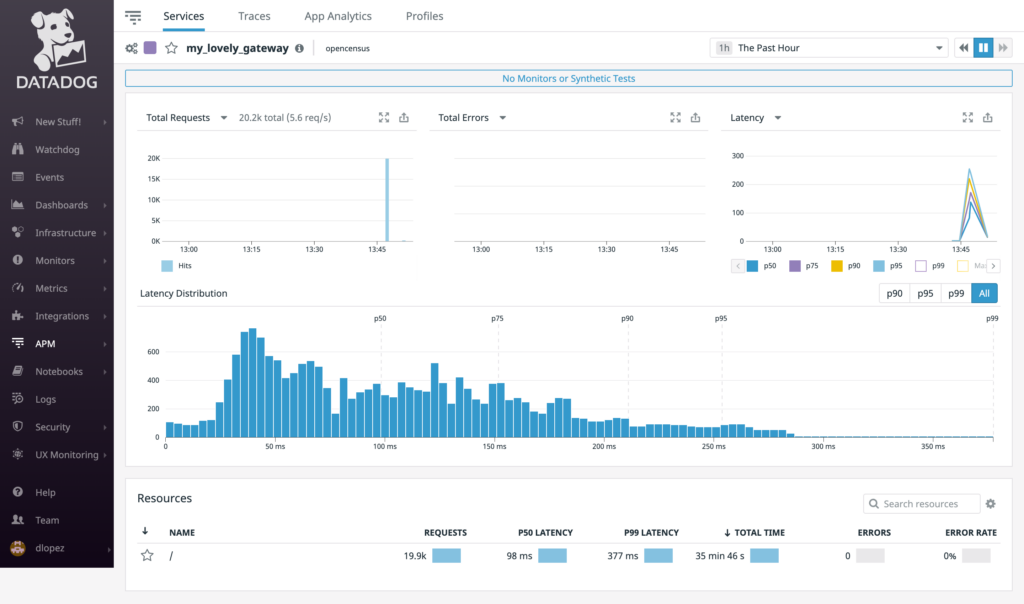
Datadog is a monitoring and analytics platform that brings together data from servers, containers, databases, and third-party services. It provides full-stack observability by unifying metrics, traces, and logs, thus serving as an excellent tool for businesses that need comprehensive integration capabilities.
Why it's a good Splunk competitor:
I picked Datadog due to its broad and holistic approach to system monitoring, making it stand out in a crowded marketplace. DevOps teams can analyze performance metrics and execute event monitoring for infrastructure and cloud services. With Datadog, organizations gain full visibility across their entire technology stack, making it optimal for those requiring extensive integration capabilities.
Standout features & integrations:
Datadog's standout features include real-time dashboards, high-resolution metrics, and anomaly detection. The platform also provides integrations with many services such as AWS, Docker, Slack, and many more, making it a robust solution for correlating events and metrics.
Pricing:
The pricing for Datadog starts from $15/user/month, making it an affordable solution considering its robust features and integrations.
Pros:
- Provides full-stack observability
- Comprehensive integrations with a variety of services
- Real-time dashboards for instant visibility
Cons:
- The interface can be overwhelming for first-time users
- Some advanced features require separate billing
- Can become expensive as the number of monitored systems grow
12. Dynatrace - Best for AI-assisted cloud infrastructure monitoring
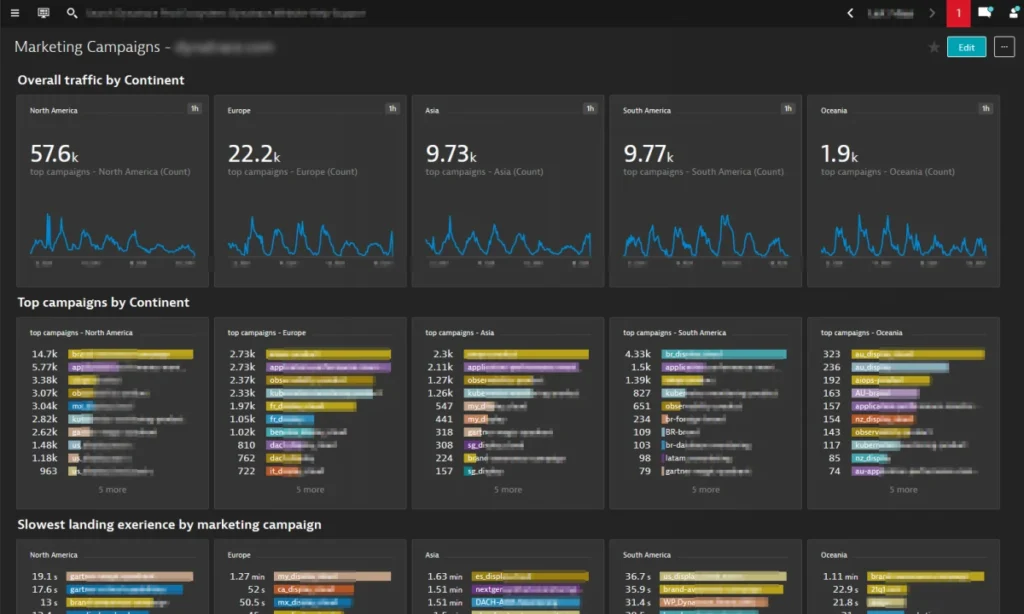
Dynatrace is an AI-powered, full-stack, and automated monitoring and analytics system. The tool provides insights into every aspect of your infrastructure, including servers, apps, and cloud systems. Its AI capabilities, particularly, set it apart for cloud infrastructure monitoring tasks.
Why it's a good Splunk competitor:
I selected Dynatrace for its impressive AI-driven analytics and automation, which simplifies complex tasks and assists in efficient cloud infrastructure monitoring. In contrast to other tools, its AI-driven capabilities offer a unique perspective, making it my choice for organizations that heavily rely on cloud infrastructures.
Standout features & integrations:
Key features of Dynatrace include automatic and intelligent observability, real-user monitoring, and synthetic monitoring. Importantly, it integrates with popular platforms like AWS, Azure, Google Cloud, Kubernetes, and more, enabling a more efficient workflow.
Pricing:
Dynatrace pricing starts from $21/user/month, providing a comprehensive AI-assisted cloud monitoring solution at a reasonable price.
Pros:
- Excellent AI-assisted monitoring capabilities
- Provides automated and intelligent observability
- Integrates with various popular platforms
Cons:
- Slightly higher starting price point compared to some competitors
- There can be a learning curve to fully utilize its features
- Customization options might be limited for certain use cases
Other Notable Competitors to Splunk
Below is a list of additional Splunk competitors that I shortlisted, but did not make it to the top 12. Definitely worth checking them out.
- Grafana Labs - Good for flexible and interactive data visualization
- ServiceNow - Good for comprehensive IT service management
- SolarWinds - Good for network performance monitoring and diagnostics
- Oracle - Good for large-scale database management
- Broadcom - Good for end-to-end software and hardware solutions
- VMware - Good for multi-cloud management and operations
- Alibaba Cloud - Good for scalable cloud services and solutions
- BMC - Good for IT service management and operations automation
- Epsagon - Good for distributed tracing for microservices
- Lakeside - Good for digital experience monitoring
- ManageEngine - Good for integrated desktop and mobile device management
- Nexthink - Good for digital employee experience management
- Sentry - Good for real-time error tracking and crash reporting
- eG Innovations - Good for application performance monitoring and diagnostics
Selection Criteria for Choosing Competitors for Splunk
In my journey to find the best Splunk competitors, I thoroughly tested and researched numerous monitoring tools. Having gone through over 20 tools, I honed in on a few key areas that stood out as crucial when evaluating these software solutions. Let me explain these criteria in more detail below:
Core Functionality:
- Log Management: The tool should be capable of collecting, storing, and analyzing a large volume of log data.
- Alerting: A good tool must provide real-time alerts for any anomaly or issue in your system.
- Data Visualizations: The tool should present data in easily understandable visual formats such as graphs and charts.
- Scalability: The tool should be able to scale as your data needs grow.
Key Features:
- Real-time Monitoring: This allows for immediate identification and mitigation of issues, reducing the impact on your system.
- Machine Learning: Tools that incorporate AI or machine learning can provide more advanced analytics and predictive capabilities.
- Data Ingestion: A robust tool should be capable of ingesting various data types and formats.
- Integration: The tool should integrate well with other systems in your IT environment.
Usability:
- User Interface: For log management solutions and monitoring tools, a clean, intuitive dashboard is crucial. The tool should present a high-level view of your system status, with the ability to drill down into detailed views as needed.
- Onboarding: The tool should offer comprehensive onboarding resources, including tutorials and guides, to get your team up to speed quickly.
- Customer Support: Fast, reliable customer support can make a huge difference, especially during critical system issues.
- Role-Based Access: The tool should offer role-based access control to ensure secure and appropriate usage. For instance, not every user needs to have access to all features or data within the tool.
- Documentation: As these tools can be complex, extensive, and easy-to-understand documentation is vital for helping users navigate the tool and its features.
Why Look for a Splunk Competitor?
Splunk is a powerful platform that collects, indexes, and analyzes machine data. This software is invaluable for businesses of all sizes, particularly those aiming to transform raw machine data into actionable insights for enhanced operational intelligence.
However, while Splunk excels in its arena, some users may seek alternatives for various reasons - perhaps they're after a more niche focus, require different pricing structures, or desire an interface that better suits their team's workflow. Therefore, finding a competitor to Splunk becomes a quest for a solution that caters more precisely to their unique needs and circumstances.
Most Common Questions Regarding Splunk Competitors (FAQs)
What are some of the benefits of using Splunk?
Splunk is renowned for its ability to ingest various structured and unstructured data. It provides real-time insights and visualizations which help in quick decision-making. The tool is also recognized for its robust search capabilities, allowing you to dive deep into your data. Furthermore, Splunk's scalability enables it to grow alongside your organization, meaning it can handle increasing data volumes. Lastly, its strong community and resource base mean you will likely find solutions to any issues you encounter.
How much does Splunk and its competitors typically cost?
Splunk's pricing is based on the volume of data the software processes daily, starting at $150 per month for 1 GB per day. However, the price can increase significantly with higher data volumes. The cost of Splunk's competitors varies greatly, from free open-source tools to premium solutions.
What are the typical pricing models for these tools?
Splunk and its competitors typically use a few different pricing models. Some, like Splunk, charge based on the volume of data processed. Others, such as SolarWinds or LogicMonitor, have tiered pricing based on the range of features included. Then there are tools like Grafana, which are open-source and free but offer paid tiers for additional features or support.
What is the typical range of pricing for these tools?
The pricing can range from free open-source tools to several hundred dollars per month for more advanced solutions. For instance, Loggly, a more affordable solution, starts at $79 per month, while a premium solution like AppDynamics might start at around $3300 per year.
Which are the cheapest and most expensive software?
Among the tools mentioned, Grafana Labs can be used for free, making it the least expensive. On the other end of the spectrum, AppDynamics is one of the more expensive options, with pricing that can go into thousands of dollars annually.
Are there any free tools available?
Yes, there are free tools available such as Grafana Labs, which offers an open-source version of its software. There are also tools like Logstash and Fluentd, which are free and open-source, but they may need some of the features found in paid solutions.
More Splunk Competitor-Related Reviews
Summary
In conclusion, selecting the best Splunk alternative requires a deep understanding of your organization's specific needs. The ideal tool should offer a comprehensive log management system, real-time monitoring, robust data ingestion, and an array of integrations. Moreover, ease of use and strong customer support should be maintained.
Key Takeaways:
- Understand Your Needs: Every organization has unique requirements. I want you to know that understanding what you need from a log management and monitoring tool is the first step toward making an informed decision. This could range from advanced analytics capabilities to the need for specific integrations.
- Focus on Usability: An effective tool should be easy to use. Look for an intuitive dashboard, efficient onboarding resources, and reliable customer support to ensure adoption and use within your organization.
- Consider Scalability: Your data needs will grow over time. Hence, the tool you select should be able to scale with you, effortlessly handling larger volumes of data while maintaining the same level of performance.
What do you think?
I hope this guide helps you navigate the multitude of Splunk competitors. However, the technology landscape is vast and ever-evolving. If you think a tool should be on this list or one that you've had great success with, please do share it. I'd love to hear about your experiences and continue refining this guide to be as helpful as possible. Your suggestions and feedback are greatly welcomed!
